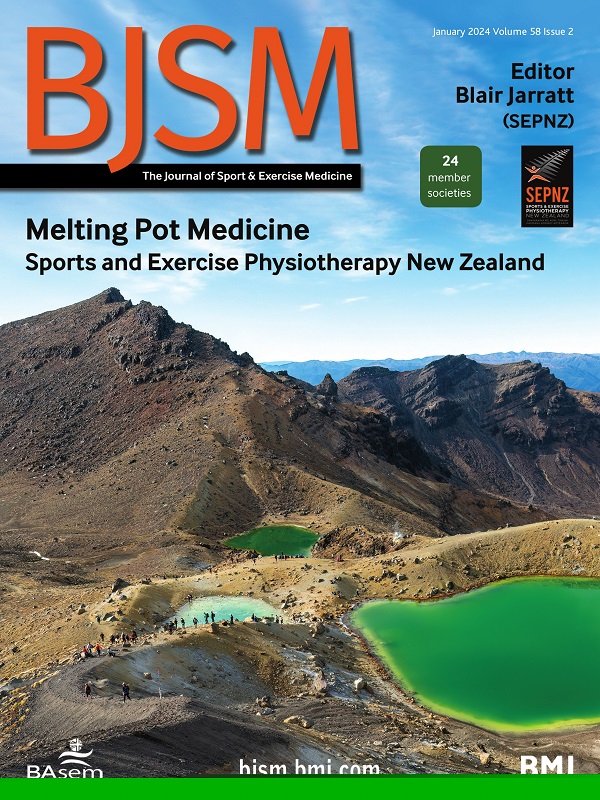Female endurance athletes: smaller hearts but similar relationship between ventricular size, fitness and fibrosis as male athletes
IF 11.6
1区 医学
Q1 SPORT SCIENCES
引用次数: 0
Abstract
Objectives Exercise-induced cardiac remodelling is well described in male athletes but incompletely understood in females. This study aimed to examine sex differences in cardiac structure, function and fibrosis relative to fitness and to determine reference ranges for ‘normal’ chamber size in a large cohort of healthy male and female highly trained endurance athletes. Methods This multicentre international study used cardiac MRI and cardiopulmonary exercise testing (VO2peak) to assess sex-specific relationships between measures of biventricular chamber size, function, fibrosis and VO2peak. Results Of the 364 endurance athletes included, 36.5% were female. Compared with males, female athletes achieved lower VO2peak (51 (40–57) vs 59 (41–65) mL/kg/min, p<0.001), had smaller absolute and body surface area (BSA)-indexed left and right end-diastolic volumes (LVEDV, respectively) but similar volumes when indexed to fat-free mass. Both sexes showed a strong association between LVEDV and VO2peak (r=0.60–0.66) and a similar coefficient describing the linear relationship between VO2peak and LVEDV (Females: VO2peak(mL/min)=12.1×LVEDV+963.9; males: VO2peak=15.3×LVEDV+806.8, p=0.100) and BSA-indexed LVEDV (females: VO2peak (mL/kg/min)=0.37×LVEDV/BSA+12.5; males: VO2peak=0.51×LVEDV/BSA-1.2, p=0.059). There was no difference between right ventricular (RV) measures and VO2peak; however, males had 3.8 times higher odds of reduced RV ejection fraction. Prevalent myocardial scar was similar for both female (14.2%) and male (19.9%) athletes (p=0.180). Conclusions Female and male athletes demonstrate similar cardiac remodelling relative to fitness and no sex difference in myocardial scar. The female athlete’s heart can show profound adaptation, and previous assertions that female hearts have lesser capacity for remodelling should be reappraised. Data are available on reasonable request.女性耐力运动员:心脏较小,但心室大小、健康和纤维化之间的关系与男性运动员相似
运动引起的心脏重构在男性运动员中有很好的描述,但在女性中还不完全清楚。本研究旨在检查与健康相关的心脏结构、功能和纤维化的性别差异,并确定大量健康男性和女性训练有素的耐力运动员的“正常”心室大小的参考范围。方法本多中心国际研究采用心脏MRI和心肺运动试验(VO2peak)评估双心室大小、功能、纤维化和VO2peak之间的性别特异性关系。结果364名耐力运动员中,女性占36.5%。与男性相比,女性运动员的vo2峰值较低(51 (40-57)mL/kg/min vs 59 (41-65) mL/kg/min, p<0.001),绝对体积和体表面积(BSA)指数左舒张末期体积和右舒张末期体积(LVEDV)较小,但无脂质量指数相似。两性均表现出较强的LVEDV与VO2peak之间的相关性(r= 0.60-0.66),并且具有相似的描述VO2peak与LVEDV之间线性关系的系数(雌性:VO2peak(mL/min)=12.1×LVEDV+963.9;男性:VO2peak=15.3×LVEDV+806.8, p=0.100)和BSA指数LVEDV(女性:VO2peak (mL/kg/min)=0.37×LVEDV/BSA+12.5;男性:VO2peak=0.51×LVEDV/BSA-1.2, p=0.059)。右心室(RV)测量值与VO2peak无差异;然而,男性右室射血分数降低的几率是女性的3.8倍。女性运动员(14.2%)和男性运动员(19.9%)心肌瘢痕发生率相似(p=0.180)。结论女性和男性运动员的心脏重构与健康状况相似,心肌瘢痕无性别差异。女运动员的心脏可以表现出深刻的适应能力,以前认为女性心脏重塑能力较弱的说法应该重新评估。如有合理要求,可提供资料。
本文章由计算机程序翻译,如有差异,请以英文原文为准。
求助全文
约1分钟内获得全文
求助全文
来源期刊
CiteScore
27.10
自引率
4.90%
发文量
217
审稿时长
3-8 weeks
期刊介绍:
The British Journal of Sports Medicine (BJSM) is a dynamic platform that presents groundbreaking research, thought-provoking reviews, and meaningful discussions on sport and exercise medicine. Our focus encompasses various clinically-relevant aspects such as physiotherapy, physical therapy, and rehabilitation. With an aim to foster innovation, education, and knowledge translation, we strive to bridge the gap between research and practical implementation in the field. Our multi-media approach, including web, print, video, and audio resources, along with our active presence on social media, connects a global community of healthcare professionals dedicated to treating active individuals.

 求助内容:
求助内容: 应助结果提醒方式:
应助结果提醒方式:


